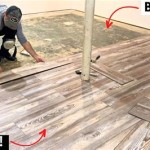How Wide Is A Roll Of Vinyl Flooring: Understanding Standard Dimensions
Vinyl flooring, a popular choice for both residential and commercial spaces, offers durability, water resistance, and aesthetic versatility. Understanding the standard widths available for vinyl flooring rolls is crucial for accurate planning, efficient installation, and minimizing waste. While the exact width can vary slightly based on the manufacturer and specific product line, there are common dimensions that serve as industry benchmarks. This article will delve into the standard widths of vinyl flooring rolls, factors influencing these dimensions, and the implications for installation and project management.
Vinyl flooring rolls are primarily available in several standard widths, typically measured in feet but often converted to inches for more precise calculations. These widths cater to different room sizes and layout configurations. Choosing the correct width can significantly reduce the number of seams required, resulting in a more visually appealing and structurally sound floor. Before purchasing, it is always advisable to confirm the exact width with the supplier or manufacturer, as minor variations can occur.
The measurement of vinyl flooring rolls considers the usable width, meaning the actual expanse of the material available for covering the floor. This distinguishes from the overall width, which may include a small, unusable border or selvage. During installation, the selvage is usually trimmed away, leaving the designated usable width. Therefore, project calculations should always be based on the usable width to ensure sufficient material is ordered.
Standard Widths of Vinyl Flooring Rolls
The most common widths available for vinyl flooring rolls are 6 feet, 12 feet, and occasionally 13 feet. These widths directly influence how many seams are necessary to cover a given area. Wider rolls, such as the 12-foot options, are particularly advantageous in larger rooms, as they often allow for seam-free installations. Understanding these standard widths is crucial when creating a flooring plan and estimating the amount of material that needs to be purchased.
A 6-foot roll of vinyl flooring equates to 72 inches in width. This size is often suitable for smaller rooms, such as bathrooms, hallways, or closets. Its narrower dimension makes it easier to handle and maneuver during installation, especially in confined spaces. When using a 6-foot roll in a larger room, seams will be necessary, and careful planning is essential to ensure that these seams are strategically placed and properly sealed.
A 12-foot roll of vinyl flooring converts to 144 inches in width. This is a popular choice for living rooms, bedrooms, and other medium to large-sized spaces. The wider dimension minimizes the need for seams, resulting in a more homogenous and aesthetically pleasing appearance. In many residential installations, a 12-foot roll can cover the entire width of a room without any joins, simplifying the installation process and reducing the potential for moisture to penetrate the seams.
In some cases, vinyl flooring rolls may be available in a 13-foot width (156 inches). This expanded width caters to particularly large spaces or unconventional room dimensions. While not as readily available as 6-foot or 12-foot options, the 13-foot roll offers an even greater opportunity to achieve a seamless flooring surface, especially in commercial settings or open-plan residential designs.
Factors Influencing Vinyl Flooring Roll Width
Several factors contribute to the standardized widths of vinyl flooring rolls. Manufacturing capabilities, transportation constraints, and installation practices all play a role in determining these dimensions. Understanding these influencing factors provides a broader context for interpreting the available width options and making informed purchasing decisions. Market demand and consumer preferences also contribute to the prevalence of certain widths over others.
Manufacturing processes dictate the feasibility of producing wider or narrower rolls of vinyl flooring. The machinery used in production has limitations regarding the maximum width that can be consistently and efficiently manufactured. Investing in equipment capable of producing wider rolls requires significant capital expenditure, which manufacturers weigh against the potential increase in sales and market share. As manufacturing technology advances, the possibility of wider standard widths may become more prevalent.
Transportation and handling considerations also impact the practical limits of vinyl flooring roll widths. Excessively wide rolls can be difficult to transport, store, and maneuver at the job site. The increased weight and bulk require specialized equipment and handling procedures, adding to the overall cost of the project. Therefore, manufacturers strive to balance the benefits of wider rolls with the logistical challenges associated with their transportation and installation.
Installation practices and the availability of qualified installers also influence the demand for specific roll widths. While wider rolls offer the advantage of fewer seams, they also require more skill and precision during installation. Installers must be proficient in handling large, heavy rolls of vinyl flooring and ensuring that they are properly aligned and secured. The availability of installers with the necessary expertise can influence the popularity of wider roll options in certain markets.
Implications for Installation and Project Management
The width of the vinyl flooring roll selected has significant implications for both the installation process and overall project management. Choosing the appropriate width can minimize waste, reduce labor costs, and enhance the aesthetic appeal of the finished floor. Accurate measurement of the room and careful planning are essential to optimizing the benefits of the chosen roll width.
When planning a flooring project, it is crucial to accurately measure the dimensions of the room, taking into account any irregularities or obstructions. This will help determine the most efficient roll width to minimize waste and reduce the number of seams required. Creating a detailed flooring plan that outlines the placement of each roll and seam is a valuable step in ensuring a successful installation.
Selecting the appropriate roll width can significantly impact the amount of waste material generated during installation. Using a wider roll that closely matches the dimensions of the room can reduce the need for cutting and trimming, resulting in less wasted material. This not only saves money but also contributes to a more sustainable and environmentally responsible project.
The number of seams in a vinyl floor can affect its overall appearance and durability. Fewer seams generally result in a more seamless and aesthetically pleasing look. Additionally, seams are potential weak points where moisture can penetrate, leading to damage and degradation of the flooring. Minimizing the number of seams through the selection of an appropriate roll width can enhance the longevity and performance of the vinyl floor.
Labor costs are also influenced by the chosen roll width. Wider rolls, while potentially more challenging to handle, can reduce the amount of time required for seaming and installation. This can translate into lower labor costs, particularly for larger projects. However, it is important to consider the skill level of the installers and ensure that they have the necessary expertise to handle wider rolls effectively.
Proper seam sealing is crucial for ensuring the long-term performance of a vinyl floor with seams. High-quality seam sealants should be used to create a waterproof and durable barrier, preventing moisture from penetrating the seams. Regular inspection and maintenance of the seams are also important to ensure that they remain intact and functional.
In conclusion, understanding the standard widths of vinyl flooring rolls and the factors influencing these dimensions is essential for successful flooring projects. From 6-foot rolls to 12-foot (and sometimes 13-foot) options, the choice of width can significantly impact installation efficiency, material waste, and the overall aesthetic of the finished floor. By carefully considering room dimensions, installation practices, and the availability of qualified installers, project managers can select the optimal roll width to achieve a durable, visually appealing, and cost-effective vinyl floor installation.

Home Decorators Collection Firview Lookout Gray 12 Mil X 7 In W 42 L Waterproof Lock Luxury Vinyl Plank Flooring 20 8 Sq Ft Case Vtrhdfirloo7x42 The Depot

Premium White Gloss Floor Wrap Removable Vinyl Event Decor Wedding Party Flooring Solution Aisle Runners
Guide

Home Decorators Collection Firview Lookout Gray 12 Mil X 7 In W 42 L Waterproof Lock Luxury Vinyl Plank Flooring 20 8 Sq Ft Case
Ultimate Guide To Sheet Vinyl Mannington

Home Decorators Collection Firview Lookout Gray 12 Mil X 7 In W 42 L Waterproof Lock Luxury Vinyl Plank Flooring 20 8 Sq Ft Case

Ultimate Guide To Sheet Vinyl Mannington

Mannington Adura Rigid Lvp Rgp031 Efloors Com

Mannington Adura Rigid Lvp Rgp690 Efloors Com

Brown Wood Texture Vinyl Printed Heat Transfer Patterned 651 631 Outdoor Htv
Related Posts








